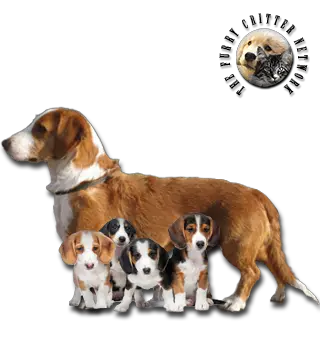Breed Standard
Head: Narrow, long, dignified. Stop not pronounced. Bridge of nose slightly curved. Lips moderately pendulous. Pale band on middle of nose. Extremely strong teeth.
Ears: Medium in length, wide, lying flat against the head, curved bluntly at tips.
Eyes: Almond-shaped, dark.
Body: Long. Moderately long neck without dewlap. Long chest, narrower than in the Dachschund. Broad, well-developed loin. Slight tuck-up. Slightly arched back with slight dip behind withers. Sloping croup.
Tail: Well set-on, ending in a tufted tip without feathering, thick brush of hair on underside. Carried erect in saber fashion or hanging down.
Hair: Harsh, very dense. Short on the head, ears, and lower legs. Longer on the neck, back, and underside of tail.
Coat: Red to yellow with a black saddle or mantle, plus typical white hound markings: flare or blaze, white around muzzle, white collar, white on chest, legs, and tip of the tail. Bicolor is undesirable, as are black markings on the head. Chocolate markings are a fault.
Size: 30 to 38 cm (11.8-15 in).
Weight: Approx. 15 kg (33 lb).
History
This very ancient breed from Westphalia was a favorite of German royalty. It is believed to be the product of crosses between medium-sized scenthounds and bassets (dachschunds, etc.). The first standard for the breed was established in 1910. Hunting use of the Westphalian Dachsbracke has been mostly supplanted by the Drever, and the Westphalian Dachsbracke is seldom seen even in its home country. The Westphalian Dachsbracke is now considered a very rare breed.
Behavior
The Westphalian Dachsbracke is obstinate and has a very keen sense of smell, a fighting spirit, and great endurance. Nimble and flexible, he can follow trails and penetrate burrows. He hunts hare, fox, and also large game (including deer and wild boar). Affectionate and obedient, he is a good companion. He needs firm training.
He is not suited to apartment life. He needs space and lots of exercise, as well as brushing twice weekly and regular checking of the ears.
Function
Hunting dog, companion dog.
Health
No Information Available






